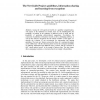Free Online Productivity Tools
i2Speak
i2Symbol
i2OCR
iTex2Img
iWeb2Print
iWeb2Shot
i2Type
iPdf2Split
iPdf2Merge
i2Bopomofo
i2Arabic
i2Style
i2Image
i2PDF
iLatex2Rtf
Sci2ools
AIME
2003
Springer
2003
Springer
The NewGuide Project: Guidelines, Information Sharing and Learning from Exceptions
Among the well agreed-on benefits of a guideline computerisation, with respect to the traditional text format, there are the disambiguation, the possibility of looking at the guideline at different levels of detail and the possibility of generating patient-tailored suggestions. Nevertheless, the connection of guidelines with patient records is still a challenging problem, as well as their effective integration into the clinical workflow. In this paper, we describe the evolution of our environment for representing and running guidelines. The main new features concern the choice of a commercial product as the middle layer with the electronic patient record, the consequent possibility of gathering information from different legacy systems, and the extension of this "virtual medical record" to the storage of process data. This last feature allows managing exceptions, i.e. decisions that do not comply with guidelines.
| Added | 06 Jul 2010 |
| Updated | 06 Jul 2010 |
| Type | Conference |
| Year | 2003 |
| Where | AIME |
| Authors | Paolo Ciccarese, Ezio Caffi, Lorenzo Boiocchi, Assaf Halevy, Silvana Quaglini, Anand Kumar, Mario Stefanelli |
Comments (0)

